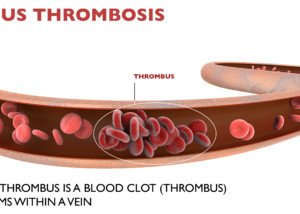
Why aren’t more people after coronary bypass surgery given an SVC filter to prevent any blood clots from becoming a pulmonary embolism, since a DVT can suddenly break off and travel to the lungs?
Experience Hits Home
To this day I still wonder why my mother didn’t have an SVC filter placed after it was determined she had a “big DVT” in her neck after CABG.
The DVT was detected via ultrasound while she was still in ICU.
Nothing was done. I was told there was a “slim” chance of it dislodging and becoming a pulmonary embolus.
And that’s true: a DVT post-CABG is rare, and it’s even rarer that it will ever embolize.
A pulmonary embolus can cause sudden death.

A “saddle” type pulmonary embolism, plugging up the area where the pulmonary artery splits off into each lung. This can cause death in minutes. Laboratoires Servier, Wikimedia Commons
However, placement of an SVC filter (think of a fishing net in the superior vena cava blood vessel, trapping blood clots, preventing them from getting into the lungs) is non-invasive and a 20 minute procedure!
“If patient not be anticoagulated and it is contraindicated, an SVC filter can be an option,” says Paul Lucas, MD, a surgeon with the Vascular Center and director of the Vascular Laboratory at Mercy Hospital in Baltimore.
“Several studies have shown that it is a safe and viable option; it does however require very precise placement, as the SVC is a fairly short vessel as compared to the IVC [inferior vena cava].
 Dr. Lucas leads a team of vascular surgeons and technologists who specialize in the diagnosis and treatment of patients with diseased blood vessels.
Dr. Lucas leads a team of vascular surgeons and technologists who specialize in the diagnosis and treatment of patients with diseased blood vessels.
 Lorra Garrick has been covering medical, fitness and cybersecurity topics for many years, having written thousands of articles for print magazines and websites, including as a ghostwriter. She’s also a former ACE-certified personal trainer.
Lorra Garrick has been covering medical, fitness and cybersecurity topics for many years, having written thousands of articles for print magazines and websites, including as a ghostwriter. She’s also a former ACE-certified personal trainer.
.








































